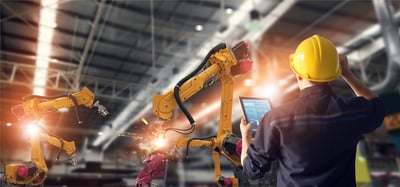 Amazon is setting the pace for warehouse and facility distribution by using modern technology like automated mobile robots (AMRs). AMRs are the more technologically advanced versions of AGVs or automated guided vehicles. They automate once previous manual tasks in a quick, efficient and cost-effective manner, with fewer errors.
Amazon is setting the pace for warehouse and facility distribution by using modern technology like automated mobile robots (AMRs). AMRs are the more technologically advanced versions of AGVs or automated guided vehicles. They automate once previous manual tasks in a quick, efficient and cost-effective manner, with fewer errors.
While AMR usage among companies other than Amazon isn’t widespread yet, the tide is beginning to turn. Every distribution company is increasingly expected to cut costs and keep up with the world’s number one distribution giant. So, let’s take a look at the advantages and disadvantages of AMRs and how you can get started using them.
AMR Advantages
AMRs offer a number of ways to provide a return on your investment, and that ROI is apparent in as little as a few months. Here’s how:
- They can be deployed within a day or a week depending on the complexity of your system. AMRs can be up and running in your warehouse in as little as 24 hours.
- They use an “internal facility map” to navigate a facility efficiently. AMRs use sophisticated lasers and sensory technology along with remote control guidance from you to map their path through your facility in real-time on day one.
- They work with your existing infrastructure. No special equipment is needed to implement AMRs in your facility. They work with your current racking, pallets, process flows, etc.
- They can help address labor shortages in “on-demand usage” situations. When you’re struggling to fill positions or see a sudden influx in product demand, AMRs can help fill the gaps without increasing labor costs.
- They can adapt to changing business processes. Because of their automation, AMRs can be reconfigured as needed to meet your evolving business needs.
Ultimately, AMRs give you a rapid prototyping option for deploying robots in your facility to move product and execute other tasks.
AMR Disadvantages
As with all technology, AMRs come with a few potential downfalls as well, and it’s important to know what risks you might be facing before implementing them in your warehouse.
- They might be too automated. It could take some trial and error to make the robot’s internal facility mapping system and algorithms work for your specific needs, including working alongside forklift operators and other employees without issue.
- Their deployment timeframe depends on the complexity of your needs. Realistically consider how long it will take you to get AMRs up and running in your warehouse and how that timeline will affect your ROI.
- They may not allow you to extend your labor pool during peak times or when operators call out. You may find yourself in a situation where an AMR would theoretically help, but your specific robots haven’t been configured for the specific situation; the time to reconfigure could be just as damaging to your business has having no AMRs at all.
- They can’t communicate with you. Real-time data, like that you receive from an employee reporting an issue, is an important part of facility management and isn’t provided by AMRs the same way it is actual employees.
- They need maintenance and repair. You’ll need a plan for how to handle malfunctions, including a relationship with an engineer or technician.
The promised benefits of AMRs are likely worth the risks associated, as long as those risks can be mitigated properly.
How to Get Started with AMRs
There are a few simple things you can do to ensure you’re getting the most value possible out of any AMRs you decide to bring into your facility.
- Do your research. When it comes to picking an AMR provider, make sure you ask the provider to deliver a compelling ROI story that’s based on your true numbers and reality. Find the best vendor for your specific business needs.
- Do a test run. Consider bringing in a team with several units during a slow season, letting them configure the AMRs in a few days and run the units for a few months. Before starting this test run, think through how to structure a simple pilot contract that offers a trial period and gets you up and running quickly if you decide to move forward. You’ll need to involve your finance team in drafting the contract as well to ensure they can sign off quickly.
- Start small. Don’t try to automate your entire warehouse at one. Pick simple processes to start with and build from there.
- Lean on the vendor. Put as much of the deployment, measurement, configuration improvement, and equipment maintenance ownership on the vendor partner as possible.
To learn more about AMRs and how they can enhance your facility’s operations, check out this video on using AMRs for flexible workflow and our blog about the unique power pitfalls and opportunities of AGVs and AMRs.
AMRs have a lot of promise, but their complexity makes using them somewhat risky. However, if you can manage that risk well, your business can see significant ROI in a short amount of time. Our advice is to weigh the pros and cons and potentially speak to an AMR/AGV or forklift dealer to discuss options--Concentric partners with many of them as the power solutions are unique for most of their applications. If the advantages seem worth the risk to your business, consider a trial to learn firsthand how AMRs can help your facility thrive.


 Ryan Lynch
Ryan Lynch

